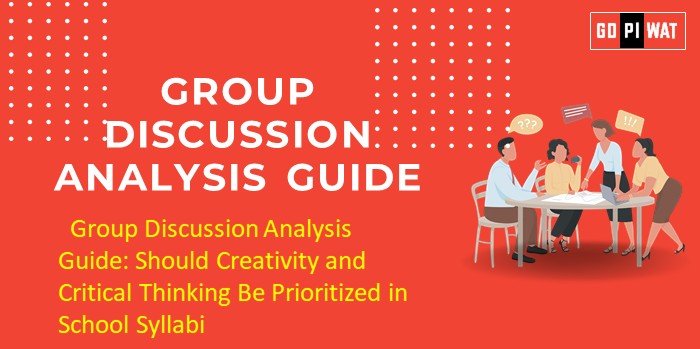📋 Group Discussion Analysis Guide: Should Creativity and Critical Thinking Be Prioritized in School Syllabi?
🌟 Introduction to Prioritizing Creativity and Critical Thinking in School Syllabi
As industries and workplaces evolve in response to technological advances, there is a growing global demand for skills beyond memorization. Creativity and critical thinking are now considered vital to prepare students for innovation and problem-solving in complex, real-world settings.
While traditional education models emphasize rote learning and standardized tests, reforms in global education—such as Finland’s skill-focused curriculum—show the benefits of embedding these skills into school systems.
📊 Quick Facts and Key Statistics
- 🌍 Global Shift: 70% of OECD countries have incorporated creative thinking into educational frameworks.
- 🏢 Employer Demand: A LinkedIn survey ranked creativity as the #1 soft skill sought globally.
- 📈 Retention Rates: Students learning through creative problem-solving retain 30% more information compared to rote learners.
- 🎓 Curriculum Reforms: Countries like Finland emphasize critical thinking and creativity, leading to higher global education rankings and student engagement.
👥 Stakeholders and Their Roles
- 🏛️ Government and Educational Boards: Develop policies to integrate creativity and critical thinking into curricula.
- 🏫 Teachers and Schools: Implement teaching methods and tools that nurture critical and innovative thinking.
- 🎒 Students: Actively engage with real-world learning processes, improving problem-solving and analytical skills.
- 👨👩👧 Parents and Society: Advocate for a system that produces well-rounded, adaptable individuals capable of innovation.
🏆 Achievements and Challenges
✅ Achievements
- 🌟 Higher Engagement: Schools emphasizing creativity report better student participation and higher academic resilience.
- 🚀 Innovation Outcomes: Countries like Finland have witnessed improved problem-solving and global competitiveness after curriculum reforms.
- 🧠 Skill Development: Creativity fosters independent thought, while critical thinking enhances logical analysis in decision-making.
⚠️ Challenges
- 📚 Testing Culture: Standardized tests prioritize memorization over skill-based evaluation, limiting innovation.
- 👩🏫 Teacher Readiness: Educators lack training and resources to adopt interactive, skills-based teaching techniques.
- 🌐 Global Comparisons: South Korea’s intensive focus on testing contrasts with Finland’s balanced model for creativity and skills development.
🌍 Global Comparisons and Case Studies
- 🇫🇮 Finland: A thematic and skills-based curriculum emphasizes creativity, resulting in better student outcomes and engagement.
- 🇸🇬 Singapore: Combines academic rigor with problem-solving and project-based learning for a balanced approach.
- 📌 India: Programs like Atal Tinkering Labs and NEP 2020 emphasize skill-based education but face implementation gaps.
📢 Structured Arguments for Discussion
- ✅ Supporting Stance: “Fostering creativity and critical thinking prepares students for innovation-driven careers and real-world problem-solving.”
- ⚠️ Opposing Stance: “Overemphasis on these skills risks diluting academic foundations that are critical for core learning.”
- ⚖️ Balanced Perspective: “While creativity and critical thinking are essential, their integration must complement foundational knowledge to ensure a comprehensive education.”
💡 Effective Discussion Approaches
- 📊 Statistical Approach: “With 70% of employers emphasizing creativity, it’s time for education systems to adapt.”
- ⚖️ Comparative Analysis: “Finland has demonstrated how thematic learning balances academics with skills development, yielding superior results.”
- 🔍 Counter-Argument Handling: “Foundational knowledge remains vital, but integrating skills alongside ensures holistic student development.”
🚀 Strategic Analysis of Strengths and Weaknesses
- ✅ Strengths: Enhances problem-solving, improves engagement, and prepares students for future careers.
- ⚠️ Weaknesses: Limited teacher training, absence of standardized assessment metrics.
- 🌟 Opportunities: Hybrid learning models and teacher development programs can drive implementation.
- 🚫 Threats: Resistance from traditional education systems and concerns about academic rigor.
🛠️ Recommendations for Sustainable Progress
- 👨🏫 Teacher Training Programs: Equip educators with tools and methods to teach creativity and critical thinking.
- 🔗 Hybrid Curricula: Integrate creativity modules alongside core subjects to balance academics and skills.
- 📊 Flexible Assessments: Develop evaluation systems that measure innovative thinking and problem-solving abilities.
✍️ Sample Short Essays
⚖️ Balanced Perspective
“While foundational learning remains essential, prioritizing creativity and critical thinking equips students with the skills needed for innovation and adaptability in the 21st century.”
🔧 Solution-Oriented
“Integrating critical thinking into school syllabi through teacher training and hybrid models can bridge the skill gap while preserving academic excellence.”
🌍 Global Comparison
“Countries like Finland demonstrate that prioritizing skills over rote learning fosters well-rounded individuals ready for dynamic global economies.”


